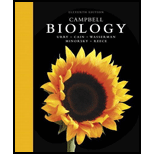
Concept explainers
Give at least three examples of key ecosystem services that nature provides for people.
To give: At least three examples of the ecosystem services that nature offers for the people.
Introduction: The important ecosystem services include the study of various species of organisms called genetic diversity. The second service includes the analysis of genotypic and phenotypic diversities in the animals, organisms, and insects found in the natural habitat like forests. The third key service includes the study of environmental diversity.
Explanation of Solution
The diversity of animals, plants, and insects is diverse. The role of animals is important in maintaining the equilibrium of the ecosystem and the natural habitat. The skin and fur of animals are important source of thermal regulation in organisms. The animal, plant, and insect products have aesthetic value in the cosmetic and beauty industry. Various plant products have medicinal value and are used for curing various diseases in the human body. The agricultural plants help in providing nutrition to humans in the form of food and fruits. The environmental diversity helps in studying the balance of nutrient cycles like carbon, oxygen, and nitrogen.
The advantages of key ecosystem services are as follows:
- Agricultural productivity increases due to crop rotation and nitrogen fixation in the soil.
- The food yield of the plant increases due to the method of hybridization.
- The higher and better varieties of animals provide milk and dairy products that are beneficial for the health of humans.
- Animal rearing and husbandry are helpful in agriculture.
- The yield of insects like lac and other secretions have aesthetic, beauty, and cosmetic values.
- Important experiments in animals help in the study of the effect of drugs.
A proper utilization of the natural resources with genetic, species, and environmental diversities are important for maintaining and conserving the environment. The cutting of trees, pollution, and the release of harmful chemical alter the climate leading to global warming. The balance of the ecosystem is important to prevent the extinction of plant and animal species.
Want to see more full solutions like this?
Chapter 56 Solutions
Campbell Biology (11th Edition)
Additional Science Textbook Solutions
Microbiology: An Introduction
Anatomy & Physiology (6th Edition)
Chemistry (7th Edition)
Biology: Life on Earth (11th Edition)
Human Anatomy & Physiology (2nd Edition)
Campbell Essential Biology with Physiology (5th Edition)
- please fill in the empty sports, thank you!arrow_forwardIn one paragraph show how atoms and they're structure are related to the structure of dna and proteins. Talk about what atoms are. what they're made of, why chemical bonding is important to DNA?arrow_forwardWhat are the structure and properties of atoms and chemical bonds (especially how they relate to DNA and proteins).arrow_forward
- The Sentinel Cell: Nature’s Answer to Cancer?arrow_forwardMolecular Biology Question You are working to characterize a novel protein in mice. Analysis shows that high levels of the primary transcript that codes for this protein are found in tissue from the brain, muscle, liver, and pancreas. However, an antibody that recognizes the C-terminal portion of the protein indicates that the protein is present in brain, muscle, and liver, but not in the pancreas. What is the most likely explanation for this result?arrow_forwardMolecular Biology Explain/discuss how “slow stop” and “quick/fast stop” mutants wereused to identify different protein involved in DNA replication in E. coli.arrow_forward
- Molecular Biology Question A gene that codes for a protein was removed from a eukaryotic cell and inserted into a prokaryotic cell. Although the gene was successfully transcribed and translated, it produced a different protein than it produced in the eukaryotic cell. What is the most likely explanation?arrow_forwardMolecular Biology LIST three characteristics of origins of replicationarrow_forwardMolecular Biology Question Please help. Thank you For E coli DNA polymerase III, give the structure and function of the b-clamp sub-complex. Describe how the structure of this sub-complex is important for it’s function.arrow_forward
- Molecular Biology LIST three characteristics of DNA Polymerasesarrow_forwardMolecular Biology RNA polymerase core enzyme structure contains what subunits? To form holo enzyme, sigma factor is added to core. What is the name of the structure formed? Give the detailed structure of sigma factor and the function of eachdomain. Please help. Thank youarrow_forwardMolecular Biology You have a single bacterial cell whose DNA is labelled with radioactiveC14. After 5 rounds of cell division, how may cells will contain radioactive DNA? Please help. Thank youarrow_forward
 Human Biology (MindTap Course List)BiologyISBN:9781305112100Author:Cecie Starr, Beverly McMillanPublisher:Cengage Learning
Human Biology (MindTap Course List)BiologyISBN:9781305112100Author:Cecie Starr, Beverly McMillanPublisher:Cengage Learning Concepts of BiologyBiologyISBN:9781938168116Author:Samantha Fowler, Rebecca Roush, James WisePublisher:OpenStax College
Concepts of BiologyBiologyISBN:9781938168116Author:Samantha Fowler, Rebecca Roush, James WisePublisher:OpenStax College Biology (MindTap Course List)BiologyISBN:9781337392938Author:Eldra Solomon, Charles Martin, Diana W. Martin, Linda R. BergPublisher:Cengage Learning
Biology (MindTap Course List)BiologyISBN:9781337392938Author:Eldra Solomon, Charles Martin, Diana W. Martin, Linda R. BergPublisher:Cengage Learning Biology Today and Tomorrow without Physiology (Mi...BiologyISBN:9781305117396Author:Cecie Starr, Christine Evers, Lisa StarrPublisher:Cengage Learning
Biology Today and Tomorrow without Physiology (Mi...BiologyISBN:9781305117396Author:Cecie Starr, Christine Evers, Lisa StarrPublisher:Cengage Learning





